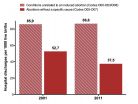CNIO scientists challenge the efficacy of folfiri in a colorectal cancer subtype
2014-11-07
(Press-News.org) The current classification system for colorectal cancer, which is based on genetic expression profiles, cannot be used to predict drug responses to FOLFIRI. This is the conclusion reached by a team from the Spanish National Cancer Research Centre (CNIO), formed by members from the Gastrointestinal Cancer Clinical Research Unit and the Structural Computational Biology Group. The study, published this week in the journal Nature Medicine, will assist oncologists in making better-informed decisions regarding how to treat their colorectal cancer patients in the clinic.
Conclusions from the analysis, led by Manuel Hidalgo, Director of the Clinical Research Programme at CNIO, are in response to previous work published in the same journal in March, 2014 (Sadanandam et al). By means of analysing gene expression profiles, Sadanandam's team designed a classification for colon cancer based on five subtypes, associating one of them, the stemlike subtype, with a better drug response to FOLFIRI; the standard treatment for this tumour type. Specifically, in a 21-patient group, 7 were classified as this subtype, 5 of whom (70%) exhibited a positive response to FOLFIRI. The authors of this article therefore concluded that the classification based on gene expression profiles is directly related to the drug response.
To confirm their conclusion, CNIO researchers, following their protocol, classified 10 patients who had previously been treated at the clinic with this therapy. Three of these patients belonged to the stemlike subtype but none of them responded to treatment with FOLFIRI. Patients belonging to the other subtypes, on the other hand, showed a response to the treatment.
"We have analysed the data from the original work and we see that it is not statistically significant, even when we increase the sample size to ours. The number of patients included in the original study is insufficient to establish a positive correlation between classification of the tumour based on gene expression profiles and sensitivity to FOLFIRI," warns researcher Raquel Martínez, the article's first author.
"Genetic classification of tumours is key to enhancing our understanding of cancer mechanisms and to make personalised therapeutic decisions," explains Hidalgo. "In this case, however, the data must be confirmed by further research studies to keep an erroneous correlation from leading doctors to prescribe inadequate treatments in the clinic."
INFORMATION:
The study has been funded by the Institute of Health Carlos III, the Ministry of Economy and Competitiveness and the National Cancer Institute (NCI, USA).
Reference articles:
Colorectal cancer classification based on gene expression is not associated with FOLFIRI response. Raquel Martinez-Garcia, Pedro P. Lopez-Casas, Daniel Rico, Alfonso Valencia and Manuel Hidalgo. Nature Medicine (2014). doi: 10.1038/nm.3701
A colorectal cancer classification system that associates cellular phenotype and responses to therapy. Sadanandam, A. et al. Nature Medicine (2013). doi: 10.1038/nm.3175
ELSE PRESS RELEASES FROM THIS DATE:
2014-11-07
Published in Nature Biotechnology, the study showed that specially engineered lipid (fat) bodies, called liposomes, can be used to prevent bacterial toxins from killing human cells.
This could prevent unnecessary deaths from diseases such as pneumonia and sepsis. The treatment is a valuable alternative to current medications, particularly for infections that have become resistant to antibiotics.
The bacterial toxins, produced by major human pathogens such as Streptococcus pneumonia, Streptococcus pyogenes and Methicillin Resistant Staphlycoccus aureus (MRSA) were ...
2014-11-07
During hibernation, dormice enter into 'torpor' to save energy and water. In this state, the dormice become inactive and show a marked decrease in their metabolic rate, causing their body temperature to reduce.
Torpor was then found to be a strategy used when food availability was limited. The researchers compared two groups of juveniles born late in the season - one able to feed freely and the other intermittently fasted on alternate days. The fasted dormice showed considerably greater use of torpor, enabling them to maintain high growth rates and accumulate sufficient ...
2014-11-07
Muscle-specific protein cofilin-2 controls the length of actin filaments in muscle cells.
Sliding of myosin and actin filaments past each other provides the force for muscle contraction. In contrast to most non-muscle cells, the actin filaments in muscle sarcomeres are of precise length and relatively stable. Defects in the organization of these actin filament arrays result in various heart and muscle disorders, such as myopathies.
The research group of professor Pekka Lappalainen at Institute of Biotechnology, University of Helsinki, has now revealed a new mechanism ...
2014-11-07
Bethesda, MD -- After many generations, rats bred for their bad attitude behave differently from those selected for a calm demeanor around humans. Research published November 7 in the journal GENETICS identifies gene regions that contribute to differences between nasty and nice rats in their behavior and the activity of genes in the brain. These results may provide important clues as to which genes make tame animals like dogs behave so differently from their wild ancestors.
"Tameness is one trait that all domestic animals share. Whether it's pigs or cats or horses, domestication ...
2014-11-07
This news release is available in Spanish.
Legal restriction of abortion has a negative connotation since the idea of women resorting to illegal abortion -risking their own lives- is strongly rooted in the public opinion worldwide. However, a series of independently peer-reviewed articles, challenge this notion in some countries. The latest data in this subject have been discussed by the Chilean epidemiologist Elard Koch, Director of Research of the MELISA Institute, in the current issue of the official journal of the Chilean Society of Obstetrics and Gynecology. ...
2014-11-07
SALT LAKE CITY, Utah, Nov. 7, 2014 - Myriad Genetics, Inc. (Nasdaq: MYGN) today presented results from a prospective clinical utility study of its Myriad myPath Melanoma test at the 2014 American Society of Dermatopathology (ASDP) annual meeting in Chicago, Ill. Myriad myPath Melanoma is a genetic test that differentiates malignant melanoma from benign skin lesions across all major melanoma subtypes. Key findings of this clinical utility study included a 43 percent reduction in indeterminate diagnoses and a 49 percent change in physicians' treatment recommendations for ...
2014-11-07
Scientists from the RIKEN BioResource Center in Tsukuba, Japan, have discovered that a single mutation in the beta-catenin gene, which codes a protein known to be deeply involved in a number of developmental and homeostatic processes, can lead to infertility not through a disruption of the production of egg or sperm cells, but rather by leading to abnormalities in the morphology of the sexual organs, making natural reproduction impossible.
Beta-catenin is an essential protein in the Wnt/beta-catenin signaling pathway, which has been shown in mice to be involved in the ...
2014-11-07
It arises from what scientists previously described as "junk DNA" or "the dark matter of the genome," but this gene is definitely not junk.
The gene GAS5 acts as a brake on steroid hormone receptors, making it a key player in diseases such as hormone-sensitive prostate and breast cancer.
Unlike many genes scientists are familiar with, GAS5 does not encode a protein. It gets transcribed into RNA, like other genes, but with GAS5 the RNA is what's important, not the protein. The RNA accumulates in cells subjected to stress and soaks up steroid hormone receptors, preventing ...
2014-11-07
The present-day extinct ancestors of turtles had a flexible ribcage and breathed, like us, by alternately expanding and contracting the lungs and thorax. The development of a solid shell on the back and belly, however, rendered this kind of respiratory process impossible. Today's turtles breathe with the aid of a muscle sling attached to the shell, which contracts and relaxes to aerate the lungs. An international team of researchers from North American, African and European institutes and museums have now discovered the origin of this muscle sling: in Eunotosaurus africanus, ...
2014-11-07
New research published today in the journal Nature Communications, has demonstrated how glass can be manipulated to create a material that will allow computers to transfer information using light. This development could significantly increase computer processing speeds and power in the future.
The research by the University of Surrey, in collaboration with the University of Cambridge and the University of Southampton, has found it is possible to change the electronic properties of amorphous chalcogenides, a glass material integral to data technologies such as CDs and ...
LAST 30 PRESS RELEASES:
[Press-News.org] CNIO scientists challenge the efficacy of folfiri in a colorectal cancer subtype

